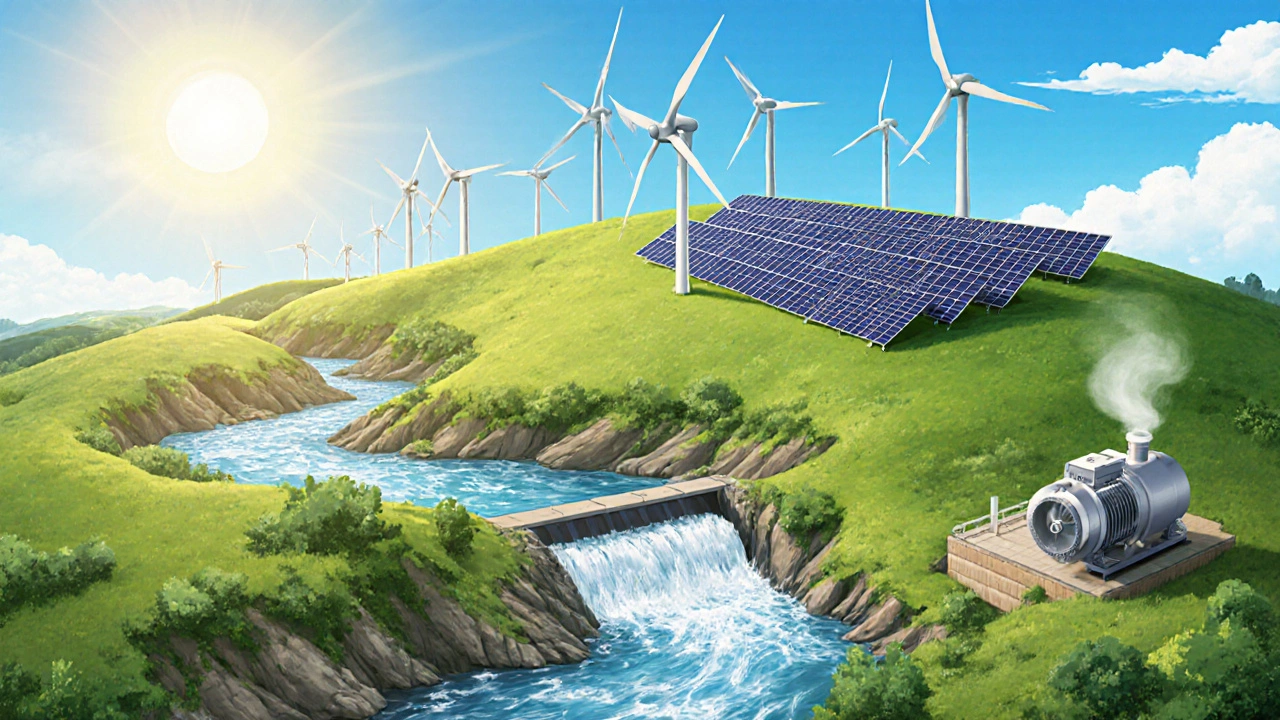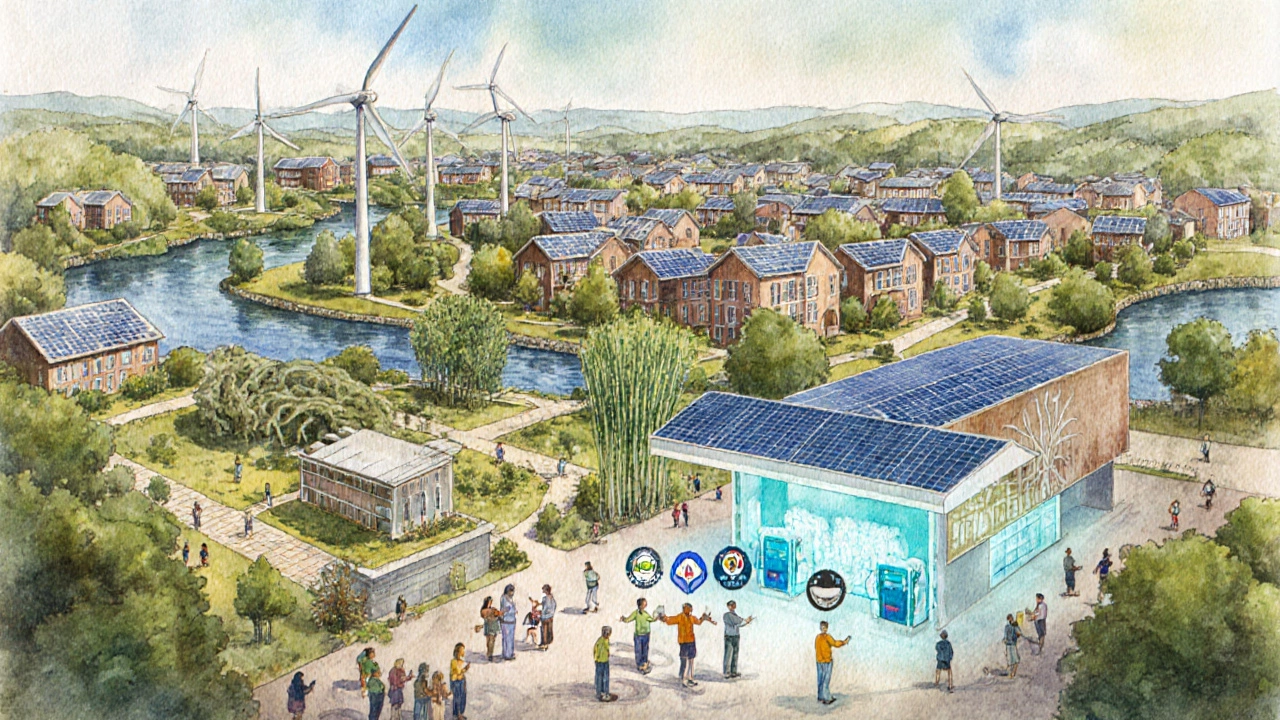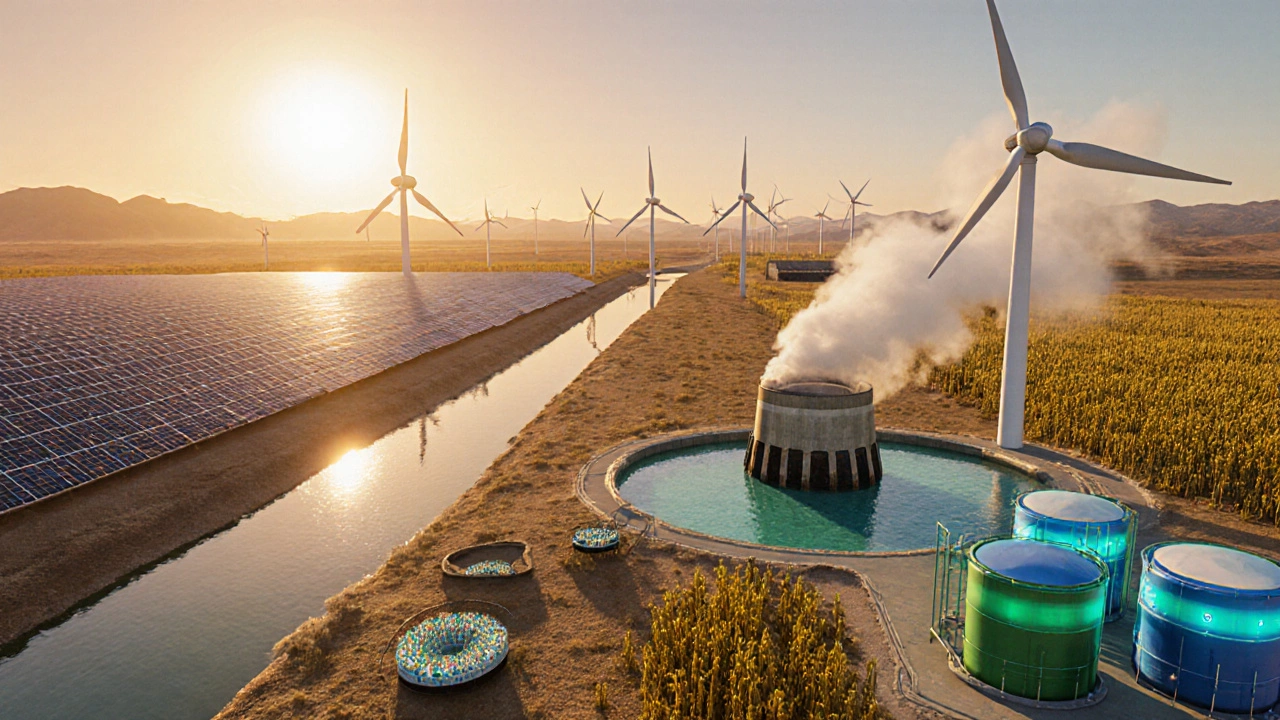Renewable Resource Assessment Tool
Find Your Best Renewable Resource
Answer a few quick questions to identify the most suitable renewable energy options for your situation based on your location, needs, and priorities.
Location & Resources
Your Priorities
Your Results
When you hear the phrase Renewable Resources is a type of natural asset that can be replenished naturally on a human timescale, you might picture solar panels or wind turbines. But the reality is far richer - from flowing rivers that turn turbines to plant material that powers bio‑fuels. Below you’ll find ten concrete examples, practical tips for spotting them nearby, and a quick checklist to help you think sustainably.
Key Takeaways
- Renewable resources span energy, materials, and fuels - all drawn from naturally replenishing cycles.
- Solar, wind, hydro, biomass, geothermal, tidal, wave, bio‑fuel, and sustainable materials each have distinct advantages and typical uses.
- Understanding local geography helps you choose the right mix for home, community, or business.
- Integrating several resources can boost reliability and cut costs.
- A simple checklist can guide you from curiosity to actionable steps.
1. Solar Energy - Harnessing Sunlight
Solar Energy is a form of renewable power captured from sunlight using photovoltaic (PV) cells or solar thermal collectors. In 2024, global PV capacity topped 1,200 GW, enough to supply a small country’s electricity needs. Homeowners install rooftop panels that convert photons directly into electricity, cutting utility bills by 30‑70% on average. On a larger scale, solar farms in deserts generate megawatts for thousands of homes. The key advantage? Sunlight is abundant, free, and produces no emissions during operation.
2. Wind Power - Turning Air into Electricity
Wind Power is a method of generating electricity by converting the kinetic energy of moving air into mechanical rotation, which drives generators. Modern turbines on the U.S. Great Plains or offshore North Sea reach hub heights of 120 meters, capturing steady breezes that translate into 2‑3 MW per turbine. In 2023, wind supplied roughly 9% of global electricity, and offshore projects are growing fastest because wind speeds are higher and more consistent at sea. Wind farms need careful siting to avoid bird collisions and noise concerns, but the payoff is clean, scalable power.
3. Hydroelectric Power - Energy from Flowing Water
Hydroelectric Power is a technology that converts the potential energy of falling or flowing water into electricity using turbines and generators. The world’s largest plant, China’s Three Gorges Dam, generates over 22,000 MW. Smaller run‑of‑the‑river projects can be built on modest streams, providing reliable baseload power without large reservoirs. Because water flow is predictable, hydro plants can quickly ramp production up or down, supporting grid stability. Environmental impacts include fish migration disruption, which modern designs mitigate with fish ladders and turbines that spin slower.
4. Biomass - Turning Organic Matter into Fuel
Biomass is a renewable material derived from living or recently deceased plants and animals, used for heat, electricity, or bio‑fuels. In rural India, agricultural residues like rice husks are burned in efficient stoves, reducing indoor air pollution while providing cooking heat. At industrial scale, wood chips fuel combined‑heat‑and‑power (CHP) plants, delivering both electricity and steam. Bio‑fuels such as ethanol (from corn or sugarcane) and biodiesel (from soybean oil) power vehicles with lower net carbon footprints than gasoline, especially when waste oils are utilized.

5. Geothermal Energy - Heat from the Earth’s Core
Geothermal Energy is a resource that taps the Earth’s internal heat for electricity generation and direct heating. Iceland generates about 25% of its electricity from geothermal plants that tap volcanic reservoirs at 150‑300°C. In the U.S., the Geysers field in California provides 1,500 MW of power. Geothermal heat pumps, common in residential settings, move heat between the ground and a building, cutting heating and cooling costs by up to 50% without moving parts that wear out quickly.
6. Tidal Energy - Power from Ocean Swings
Tidal Energy is a form of marine power that captures the kinetic energy of rising and falling tides using barrages or underwater turbines. The world’s first commercial tidal stream farm at La Rance, France, has been operating since the 1960s, delivering 240 MW. Newer projects in Canada’s Bay of Fundy exploit the world’s highest tidal range (up to 16 meters) for predictable, low‑maintenance power. While site‑specific, tides are extremely reliable - they follow lunar cycles rather than weather.
7. Wave Power - Energy from Surface Waves
Wave Power is a technology that converts the up‑and‑down motion of ocean surface waves into electricity via buoys, oscillating water columns, or hinged plates. Pilot plants in Portugal and Scotland have demonstrated capacity factors of 30‑40%, higher than many wind sites. Wave devices can be deployed near coastlines, supplying islands or remote coastal communities with clean electricity. The challenge lies in surviving harsh marine environments, but advances in corrosion‑resistant materials are lowering maintenance costs.
8. Bio‑fuel - Liquid Energy from Organics
Bio‑fuel is a liquid fuel produced from biological sources such as crops, algae, or waste, used primarily in transport. Ethanol from sugarcane in Brazil powers over 30% of the country's car fleet, cutting CO₂ emissions by up to 20% compared to gasoline. Algae‑based biodiesel offers high oil yields per acre, promising a future where fuel comes from ponds rather than farmland. Lifecycle analyses show that when feedstock is sourced sustainably, bio‑fuels can achieve a net‑negative carbon balance.
9. Sustainable Materials - Renewable Building Blocks
Sustainable Materials are products derived from renewable resources that replace fossil‑based equivalents in construction, packaging, and manufacturing. Bamboo, for example, grows to maturity in 3‑5 years and can replace timber in flooring and furniture. Mycelium (fungus) composites are being used for biodegradable packaging, while hempcrete offers carbon‑sequestering insulation. These materials reduce landfill waste, lower embodied energy, and often improve indoor air quality.

10. Green Hydrogen - Energy Carrier from Water
Green Hydrogen is a hydrogen gas produced by electrolyzing water using electricity from renewable sources, resulting in zero‑carbon fuel. In 2025, Europe launched the Hydrogen Backbone, a network of pipelines intended to transport green hydrogen across borders. When paired with fuel cells, it powers buses, trucks, and even ships without emitting CO₂ during operation. The key challenge remains the cost of electrolyzers, but falling renewable electricity prices are narrowing the gap.
How to Spot Renewable Resources Near You
- Check solar irradiance maps - many national meteorological agencies publish average daily sunlight data.
- Identify windy corridors - coastal regions, mountain passes, and open plains often have higher wind speeds.
- Locate rivers or streams with sufficient flow - local water‑resource agencies list flow rates useful for small‑scale hydro.
- Explore agricultural waste streams - crop residues, livestock manure, or food‑processing by‑products can feed biomass projects.
- Research geothermal gradients - counties with known hot springs or volcanic activity often have exploitable heat.
Quick Checklist for Choosing a Renewable Resource
- Resource Availability: Is the sun, wind, water, or biomass plentiful locally?
- Initial Investment: What capital is needed for installation and maintenance?
- Regulatory Support: Are there subsidies, feed‑in tariffs, or permits that simplify deployment?
- Environmental Impact: Does the option affect wildlife, water quality, or land use?
- Scalability: Can the system grow from a household unit to a community‑scale plant?
Comparison of the Ten Renewable Resources
| Resource | Typical Use | Average Capacity Factor | Main Advantage | Key Limitation |
|---|---|---|---|---|
| Solar Energy | Electricity for homes, utilities | 15‑25% | Abundant, modular | Intermittent, land use |
| Wind Power | Utility‑scale farms, offshore | 30‑45% | High energy density | Noise, visual impact |
| Hydroelectric | Baseload electricity | 40‑60% | Dispatchable, storage | Ecological disruption |
| Biomass | Heat, CHP, bio‑fuels | 20‑30% | Uses waste streams | Air emissions if not managed |
| Geothermal | Electricity, heating | 70‑90% | Stable, low emissions | Site specific |
| Tidal Energy | Coastal power | 35‑45% | Predictable cycles | Limited sites |
| Wave Power | Island and offshore supply | 30‑40% | High energy potential | Marine harshness |
| Bio‑fuel | Transport fuels | Varies | Drop‑in replacement | Land competition |
| Sustainable Materials | Construction, packaging | N/A | Carbon sequestration | Performance trade‑offs |
| Green Hydrogen | Energy storage, heavy transport | N/A | Zero‑carbon carrier | Electrolyzer cost |
Frequently Asked Questions
Which renewable resource is the cheapest to install for a homeowner?
Solar PV panels typically have the lowest upfront cost per kilowatt‑hour generated for residential users, especially after applying local tax credits and net‑metering incentives.
Can I combine multiple renewable resources on a single site?
Yes. Hybrid systems that pair solar with wind or battery storage are common, improving reliability and smoothing out supply fluctuations.
How long does a wind turbine typically last?
Modern turbines are designed for 20‑25 years of operation, with many reaching 30 years after major component upgrades.
Is biomass energy truly carbon‑neutral?
When the feedstock is sourced sustainably and the combustion efficiency is high, the carbon released matches the carbon absorbed during plant growth, making it effectively carbon‑neutral.
What are the biggest barriers to adopting tidal energy?
High upfront capital, limited suitable sites, and the need for marine‑grade infrastructure are the main hurdles.



